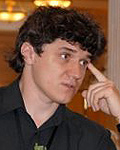Towards Light-Spin Interface for NV Center in Diamond
Category
Published on
Abstract
One of the key challenges in modern quantum information processing is to enable efficient transfer of quantum information stored in atomic-like systems into almost perfect information carriers - photons. Besides quantum information processing and communication, efficient quantum interfaces are highly demanded for metrological and sensing applications. Recent developments in the field of metamaterials opened a way to create structures out of hyperbolic metamatherial using CMOS compatible materials. Use of this material, especially in combination with an optical fiber, may open a way to create efficient and industry-friendly interface for nitrogen- vacancy (NV) centers and, in particular, single-photon source based on NV. In this work we present our efforts on using CMOS compatible hyperbolic metamaterials and optical fibers to construct efficient single-photon sources and sensing elements using NV center in diamond.
Bio
 Alexey graduated and then got his PhD from Moscow Institute for Physics and Technology in 2000 and 2003, respectively. In 1997 he joined the laboratory for active media at Lebedev Physical Institute. His research was focused on narrow optical resonances and its applications for metrology, both using hot and laser cooled atoms. In 2006 while keeping part time position at Lebedev, he joined Misha Lukin group at Harvard, where he started to work with plasmons, quantum dots, and NV centers. Main focus of this activity was light-spin interfaces and solid state nanophotonics. In particular novel approach on using plasmon nanowires for light collection and Purcell enchantment of nano emitters was realized. In 2010 he was involved in Russian Quantum center (RQC) initiative and became its acting director for the first 2 years of the Center development. Currently he is Principal Investigator at RQC, where he is conducting research in both fields of cold atoms and solid state spin systems.
Alexey graduated and then got his PhD from Moscow Institute for Physics and Technology in 2000 and 2003, respectively. In 1997 he joined the laboratory for active media at Lebedev Physical Institute. His research was focused on narrow optical resonances and its applications for metrology, both using hot and laser cooled atoms. In 2006 while keeping part time position at Lebedev, he joined Misha Lukin group at Harvard, where he started to work with plasmons, quantum dots, and NV centers. Main focus of this activity was light-spin interfaces and solid state nanophotonics. In particular novel approach on using plasmon nanowires for light collection and Purcell enchantment of nano emitters was realized. In 2010 he was involved in Russian Quantum center (RQC) initiative and became its acting director for the first 2 years of the Center development. Currently he is Principal Investigator at RQC, where he is conducting research in both fields of cold atoms and solid state spin systems.
Cite this work
Researchers should cite this work as follows:
Time
Location
Birck Technology Center, Room 2001, Purdue University, West Lafayette, IN